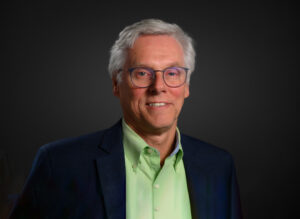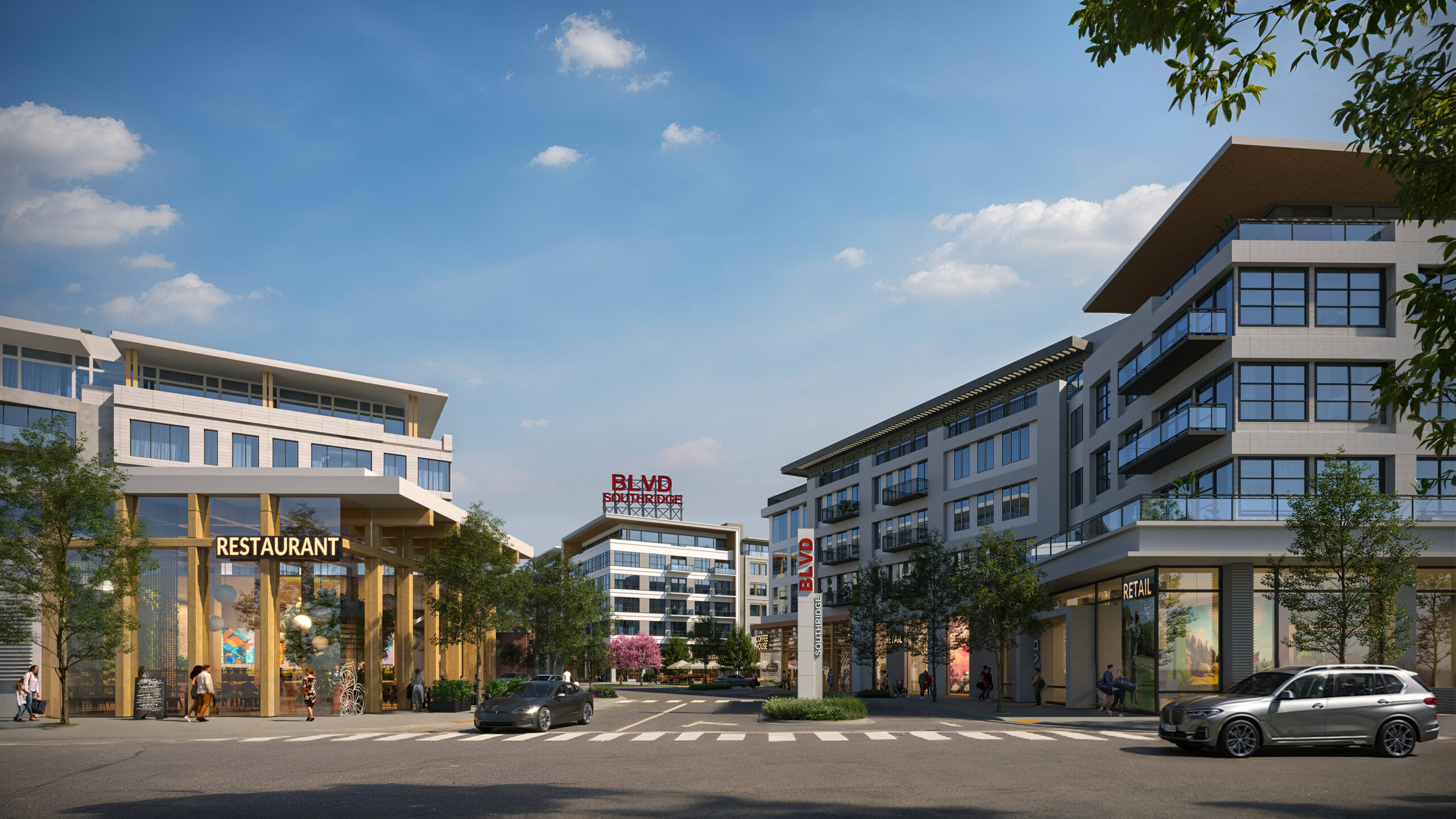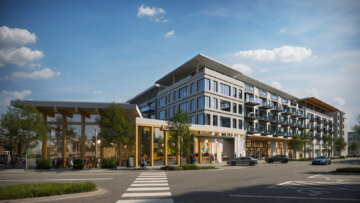KTGY’s Craig Pryde on addressing the housing shortage by breathing new life into old retail spaces.
 Retail has seen its fair share of challenges over the past decade, with many properties now abandoned or in great need of a general makeover to restore their appeal.
Retail has seen its fair share of challenges over the past decade, with many properties now abandoned or in great need of a general makeover to restore their appeal.
One such example is the former Boston Store at Southridge Mall, a 1970s shopping mall located in the Milwaukee suburb of Greendale, Wis. The 220,000-square-foot building closed in 2018 and sat vacant until 2021.
Now, Barrett Lo Visionary Development intends to redevelop the 15-acre property into a mixed-use destination. Designed by KTGY, the multiple phase project is set to include approximately 675 apartments, as well as modern retail spaces and a public plaza. Plans also call for a pool, fitness center, club lounge, dog spa, golf simulator, package room and coworking space.
Multi-Housing News asked KTGY Principal Craig Pryde to expand on this redevelopment project, which stands as an example of how underutilized retail spaces can be transformed into vibrant communities that address the country’s housing shortage.
What’s the architectural vision behind the redevelopment of Southridge Mall’s Boston Store?
Pryde: In collaborating with our development partner BLVD on the redevelopment of the Boston Store property at Southridge Mall, KTGY is seeking to create a new mixed-use destination, transforming Southridge Mall into an oasis for luxury residential living, casual retail experiences and outdoor community-based events such as farmer’s markets, craft fairs and other civic-oriented activities.
The emphasis is on creating community. So, the new residential buildings orient themselves around a shared circular drive court and central green space. The architectural style leans into contemporary with clean lines and enlarged windows to allow the connection of the interior environments to the exterior public spaces.
How did you ensure a seamless integration between the new residential development and the existing mall?
Pryde: The development will be adjacent to the existing mall, so the designers created an entrance that aligns with the existing entrance to the mall from 76th Street which provides a ‘main street’ atmosphere similar to downtown Greendale, with shopping, housing and outdoor amenity spaces. A new public space at the core of the development compliments other retail locations within the Southridge Mall area.

Why was it important to center the project around this public space?
Pryde: The proposed development needed a ‘heart’ to provide connectivity to the existing fabric of the area as well as between the residential uses which will come to life in phases.
We design with a people-centric approach. At Southridge Mall, that meant taking a sea of parking and creating a space that would allow for the interaction activities and establishing an environment that people would want to return to.
This village green features walkways, benches, trees, a center fountain and retail space imbuing the area otherwise dominated by structures with a connection to the natural world. With this design, visitors are enticed to come into the space to enter a personal-scale plaza and linger. This area provides space for public events and attractions, opening the new development to the surrounding community, inviting the neighbors in and encouraging engagement.
Please expand on the walkability aspects of the project. How easy will it be for residents and visitors to move around?
Pryde: The village green and central plaza feature walkways, open space and a careful circulation of people and traffic. Garages and surface parking keep vehicles away from pedestrian areas, securing the main street character, increasing overall efficiency and balancing pedestrian and vehicle circulation for residents and mall visitors.
Malls and other shopping centers in suburban markets such as Greendale are dependent on the public transportation or automobiles to reach the destination. The proposed development and its associated exterior spaces provide for outdoor activities within the residential community while being connected to the existing circulation of the mall and surrounding community.
Tell us more about the different phases of the project.
Pryde: The initial phase is envisioned to include a mixed-use, podium-style residential building, public plaza and relocation of the internal roadways/parking to prepare for future phases. This includes approximately 230 residential units located in the space once occupied by the Boston Store. Phase 2, immediately west and opposite Phase 1 will include approximately 175 residential units. Phase 3 will be on the north end of the public plaza and include approximately 160 units, while Phase 4 will be located adjacent to Phase 2 and include approximately 110 units.
Phases 1, 2 and 3 will include retail space on the ground level adjacent to the public plaza or main street entrance and will total approximately 25,000 square feet. All phases will include enclosed parking for residential and retail uses.
What are the main challenges when working on large, multi-phase projects like this one?
Pryde: Large-scale projects, such as this one, require collaboration with existing operations, utilities and traffic considerations. We want to ensure that the current uses can function seamlessly amidst the new development while we are setting the stage for future development in the adjacent land area.
Malls were originally established with restrictive easements that did not allow for residential uses and other activities to ‘protect’ the retail environment. Changing these easements requires several entities to align with any proposed redevelopment and BLVD/Village of Greendale were key partners and collaborators in this process.
Please expand on your collaboration with Barrett Lo Visionary Development and the Village of Greendale. To what extent has the Village had a say in the project’s design?
Pryde: KTGY has worked closely with BLVD and the Village of Greendale throughout the concepting phase. This design is the culmination of more than two years of effort to establish the design potential, density, uses and architectural vision. Once KTGY presented the vision, the Village Board became enthusiastic about the opportunity and moved forward with the purchase of the property. BLVD, and subsequently KTGY, were chosen as the developer and architect capable of bringing this vision to life.
We leveraged our national knowledge around mall redevelopment and local expertise to fulfil BLVD’s desire to create a new housing district within Greendale. …
BLVD and KTGY’s branding studio continue to collaborate with the Village of Greendale around establishing the identity of this new enclave within Southridge Mall to ensure that it will resonate with and contribute to the community.
How will this redevelopment address housing needs and cater to the village overall? What will be the impact of this project on the Southridge Mall area?
Pryde: Greendale is a heavily residential community with a very high occupancy rate within its rental units. … The provision of new rental housing will allow it to welcome new residents and revitalize Southridge Mall as a live-work-play destination.
The mall, like many around the country, has recently struggled to attract shoppers and retail tenants and our vision for a mixed-use district revitalizes and engages this place as a destination for the next generation of shopper, retailer and resident. The fresh vision for the site builds on what people love about the Southridge Mall, reimagining it to sustain it, so families can enjoy this place for years to come.
The BLVD development at Southridge Mall will be a catalyst for other potential development at Southridge Mall and within Greendale as it will showcase the creativity and opportunity that mixed-use developments can achieve within a community. Each phase will build upon the success of the previous phase and create momentum … to bring in new residents, activities and visitors.

